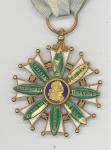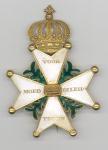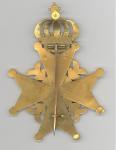
JBFloyd
Moderator-
Posts
1,242 -
Joined
-
Last visited
-
Days Won
2
Content Type
Profiles
Forums
Blogs
Gallery
Events
Store
Everything posted by JBFloyd
-
Sadder yet that it turns up at militaria shows in the hands of people who should know better. They're often priced as if they had value beyond curiosity.
-
All fakes made for the current tourist trade in China. Key points: 1. All bronze, with painted enamel. 2. All with the same style of ribbon and suspension bars (with tiny pins) 3. A mix of Nationalist and Communist symbols (sometimes Manchukuo) Pre-1947 Nationalist awards are usually of much higher quality. Their ribbons were usually similar to Japanese ribbons in quality and style. They were never on plain red ribbons.
-
Portugal - Commander's Cross
JBFloyd replied to JBFloyd's topic in Southern European & Balkan States
There are several variant ribbons that have appeared with these awards, but the style seen on the Commander's Medal is the one most commonly seen. The ribbon on the Commander's Cross is a blue and white striped ribbon that is not original to the piece (it looks bavarian or Greek). -
Portugal - Commander's Cross
JBFloyd replied to JBFloyd's topic in Southern European & Balkan States
Here is Commander's Medal for two actions (Nive and Nivelle). These cannot be attributed, unfortunately. -
Portugal - Commander's Cross
JBFloyd replied to JBFloyd's topic in Southern European & Balkan States
The Commander’s Cross was established in 1816 for those officers, Portuguese or British, who had been in command of a Portuguese battalion, regiment, brigade or division in specified actions. Officers who took command when a senior officer was killed or wounded in action also received it. Officers who qualified in three or more actions received the Commander’s Cross, while those who qualified in one or two actions received the Commander’s Medal. The number of arms on the star varied with the individual's qualifications. The Commander's Cross started with 3 arms and went as high as 12. Sources vary on who received the Cross or Medal, but it appears that a total of 161 awards were made. I find one Portuguese officer with these initials (Conde de Villa Flor) who meets the 8 action criterion and Gordon's notes that 2 British officers qualified at the 8 action level as well. -
Here's an exceptionally rare Portuguese Commander's Cross for 8 Actions in the Peninsular War. The actions were “Busaco”, “Nivelle”, “Cd. Rodrigo”, “Toulouse”, “Albuhera”, “Nive”, “Badajos” and Orthes”. These medals were individually made based on the officer's record and the recipient's initials are in the reverse center.
-
Netherlands Dutch Order of Willem star 1816
JBFloyd posted a topic in Northern European & Baltic States
Here's a remarkable piece of history -- a British-made breast star of a knight commander of the Dutch Order of Willem (94x66mm, including the crown). With hallmarks and a date-letter for 1816. Since the order was only created in 1815, this would be one of the first awarded. The roll in G.C.E. Koffler’s book, “De Militaire Willemsorde 1815-1940" shows only three British officers receiving the Knight Commander grade of the Willem Order prior to 1825: General Henry William Paget, 1st Marquess of Anglesley (1815); General Rowland Hill, 1st Viscount Hill (1815); and Admiral Sir David Milne (1816). -
Question on the Order of the Crown of Hawaii
JBFloyd replied to pieter1012's topic in Rest of the World: Militaria & History
The order was limited to no more than 25 grand officers at any time. -
The rolls were privately published and getting hard to find. They were published by the late Col Al Gleim's Planchet Press. Al was the premier American medal researcher. Williams, JoAnn and Robert H. Reynolds. Mexican Border Service Medal Issue Records: Part I - Serial Number Issue Listing. Planchet Press Pub 65PI, 1996. Williams, JoAnn and Robert H. Reynolds. Mexican Border Service Medal Issue Records: Part II - Name Index. Planchet Press Pub 65PI, 1996.
-
What's the number?
-
THE EARLIEST MILITARY MEDALS AWARDED
JBFloyd replied to QSAMIKE's topic in Rest of the World: Militaria & History
Alex Laslo wrote "A Short History of Roman Military Decorations" for the OMSA Journal of Jan-Feb 1993 (Vol 44, No.1, pp4-12). There is also a book on the subject, by Valerie A. Maxfield "Military Decorations of the Roman Army" (Berkeley, CA, 1981). It's an academic work more on the awards system and history than the phalera themselves. -
I know of partial rolls for British and American recipients (but don't have copies of either in my files), but I have never seen a roll of other recipients.
-
The Panamanian Medal of Solidarity is scarce in any class. Only 100 were issued to each of the Allies. The first class (in gold) went to senior officers; the second class (bronze with rosette) to Lt Colonels, colonels and brigadier generals; the third class (bronze, without rosette) to anyone else. Very few ever appear in the market. The Order of the British Empire, as an honorary award to a foreign officer, will not appear in the London Gazette. I've never run into any foreign recipients listed in the 1921 Handbook of the Order of the British Empire, so he's probably only listed in Belgian sources.
-
The last ribbon appears to be a Panamanian Order of Solidarity, second class.
-
new ribbon bars they possible?
JBFloyd replied to paddywhack's topic in Great Britain: Orders, Gallantry, Campaign Medals
The first is an unlikely combination. The military British Empire with no corresponding WWI or WWII awards raises red flags. The second is certainly possible. These ribbons could have been earned in a 10-year span, so the absence of a long service award is not a problem. -
I attended the Spink sale that included the Dickin Medal to Simon the Cat, HMS Anythyst. A pet food company had sent two young women to represent them in the bidding. A break was called just before the Dickin Medal came up so the press and news cameras could be ready. The auction restarted with cameras rolling and the bidding took off. The two young women simply held up their bidder's card until everyone else fell to the wayside, winning the lot in short order. When the press tried to interview the young women, it was immediately clear that they had no idea what they were bidding on, but were simply following directions. It was a bit of an anti-climax after several days of buildup in the press and the extensive write-up Spink had done. More recently there was a Dickin Medal to a WWI messenger pigeon. The medal was in a glazed box with the stuffed pigeon. It was the only situation I can recall where you could buy the medal and the recipient.
-
Finland My first Finnish medal
JBFloyd replied to Deruelle's topic in Northern European & Baltic States
Jani Tiainen's new book indicates 15433 awarded of 20000 manufactured. If you haven't seen Jani's book, "Soumen Kunniamerkit: The Orders, Decorations and Medals of Finland" (Tampere, 2010), it is a real treat -- beautiful photographs, weights and measures of awards and numbers awarded. Finnish and English text (hardbound, 319pp). -
Michael Shank operates on eBay as MCSTLS, based in Huntington, West Virginia. He is the son of George Shank, who operated the business before him. Shank sells an array of bogus WWI Victory Medals, UN Korea Medals, NACA/Medals, oversized Coast Guard Good Conducts, Nickel Crosses, Sampson Medal, Dewey Medals, etc, etc. I'm not sure I've ever seen a real medal among his stock.
-
Those of us who sell real medals from Virginia prefer NOT to be confused with Mr. Shank, the seller from WEST Virginia.
-
It's been reribboned on a split brooch (should be on a wrap brooch). The surface looks odd and I suspect that it's a new strike that has been chemically treated. At $38, it's too expensive for a new strike and too cheap for an old strike.
-
I know who wound up in penal units in the Red Army (and the opportunities they were given to excell), but does anyone know if the officers of such units were chosen from among the politically reliable (and therefore ready to mete out draconian punishments without flinching), or were they similar to the rabble they commanded (and therefore ready to mete out draconian punishments without flinching)?
-
Unless the Chancery has changed a long-standing policy, they do not answer inquiries about the numbers on orders.
-
Peruvian Order of Police Merit
JBFloyd replied to jeffskea's topic in Rest of the World: Militaria & History
The Peruvian Order of Police Merit is getting to be relatively common these days, as several ebay sellers in Lima seem to have ready access to the manufacturer/police stocks. Because of the absence of decent sources in English (oe Spanish, for that matter),Latin American awards have not been highly collected, so there are bargains out there. The low quality of workmanship on recent awards (such as this one), has also reduced the number of collectors. Pieces made at the Lima Mint are much higher quality. There are a few hard-core collectors here, but the sources are very sporadic. Ebay has been a great source of relatively cheap Latin American awards.







